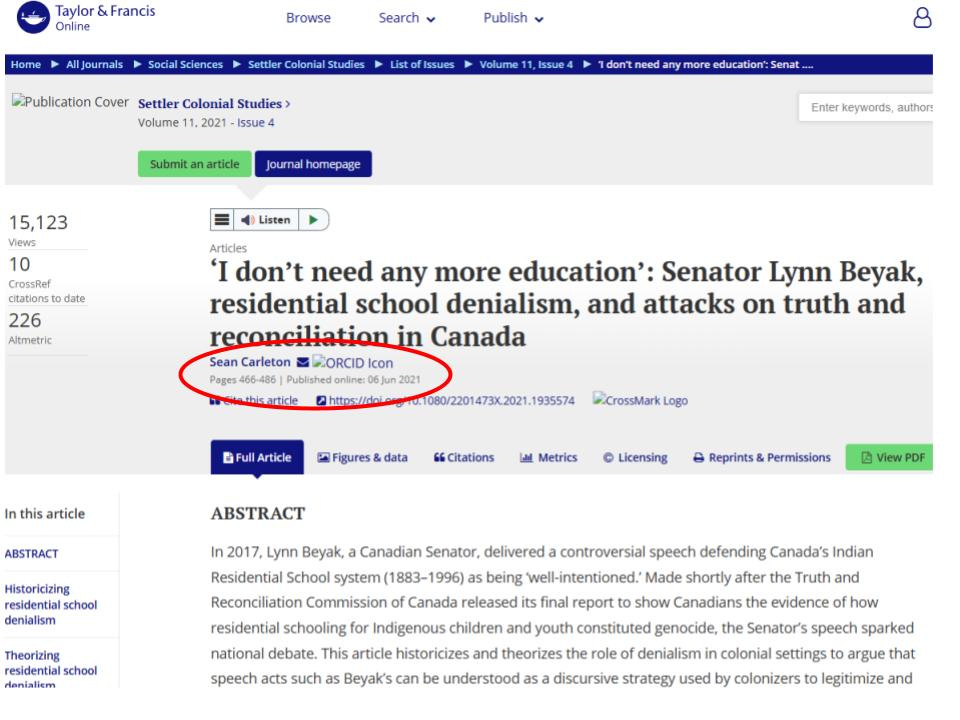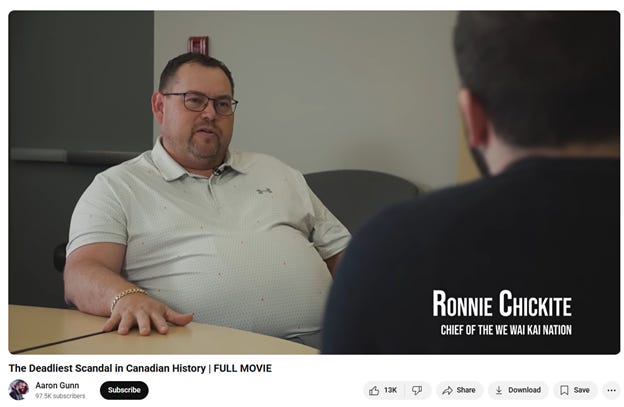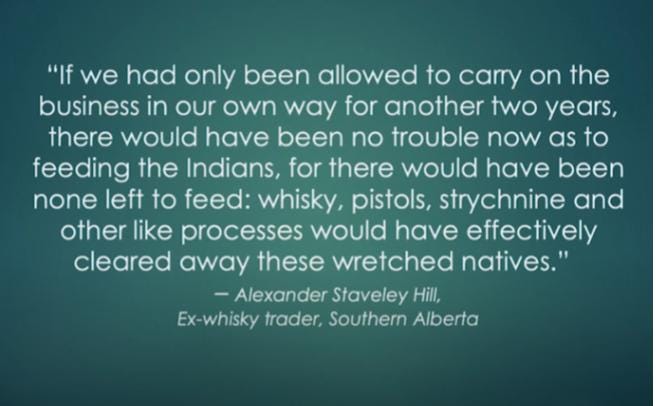By Michelle Stirling ©2025
History is replete with people making fantastic claims that are later debunked by facts. Often, in the interim, those making the claims have made fantastic money or become famous because of them. One such claim is that of the Piltdown Man where in 1912, an amateur archeologist and others pieced together bones claiming to have found the missing link between man and ape. It took decades, but by 1949 it was revealed that this was a hoax; the amateur archeologists had created a believable story, but one not based on facts.
Such is the case for Sean Carleton, a self-described ‘settler’ historian who likes to rag on any person who challenges the claim of ‘genocide’ regarding Indian Residential Schools – like Aaron Gunn, Conservative Party Candidate for North Island-Powell River.
Carleton and many others at the University of Manitoba have made a career of denigrating the work of thousands of dedicated priests and nuns, other clergy, Indigenous staff and government workers who worked for paltry wages in the service of Indigenous education. They could never imagine the kind of salaries, benefits and accolades that settler-historian academics like Sean Carleton get today, for destroying their reputations, good will, and devotion to G-d.
Carleton’s most recent article in Canadian Dimension hammers Aaron Gunn as a “residential school denialist” when it is self-evident that none of today’s Indigenous leaders could have participated in mainstream society in fields of law, politics, history, medicine, or governance if they were still hunter-gatherers speaking their own obscure languages and engaging in pre-contact customs like infanticide, slavery, horse-stealing raids, and potlatch homicide.
Since Indian Residential Schools were intended to acculturate hunter-gatherer children to the new forms of survival in the agro-industrial-technical world they must be responsible for the Great Medicine that all Indigenous people ultimately encountered. The written word. The talking paper. As I have written elsewhere:
“…Our children and grandchildren will be taught the magic art of writing. Just think for a moment what that means. Without the aid of a spoken word our children will transmit their thoughts on a piece of paper, and that talking paper may be carried to distant parts of the country and convey your thoughts to your friends. Why even the medicine men of our tribe cannot perform such miracles.” Shingawuk’s Vision
The purpose of the Indian Residential Schools was the equivalent of today’s “Learn to code.” A just transition to a new world. In the words of Duncan Scott of Indian Affairs at the time: “I do not think as a matter of fact, that the country ought to continuously protect a class of people who are able to stand alone…” As stated in the TRC reports, Indian Residential Schools were the choice of the Indigenous elite.
In addition to food, clothing, and shelter, many former staff said, parents sought out the residential school for the opportunities the school could offer their children. “Who came to residential schools?” asked former teacher Olive Saunders: “The elite. The councillor’s children, his family’s children, the Chief’s children.… They were wonderful kids. They were smart kids. So they were the elite … because their parents knew that someday their kids would need to be educated.”332 James Fiori felt that residential schools constituted the only educational opportunity available to students: “I know some of the ones that I have talked to of the whole thing, if they don’t have an education, they will not have a chance. And you know, like I know the north country, you know, like there simply wasn’t anything available.”333 (pg. 535[1])
So, it seems that Sean Carleton is misleading the public about whether or not children were sent to these schools or taken by force and whether or not parents actively sought out better futures for their children. The foregoing indicates that the Indigenous elite wanted their children to have education. Attendance at an Indian Residential School was restricted to Status Indians and if there was a day school on reserve, where children went home every night (just as off-reserve children do at public school) then parents could choose that option. Since only Status Indians could attend Indian Residential School (this being part of treaty obligations to provide education), this means that only about one sixth of all potential Indigenous students even attended Indian Residential School (Inuit and Metis were also exempt).
But attendance and educational outcomes at day school were poor compared to the boarding school context. Some parents chose residential school for their children for that reason, to provide more consistent educational outcomes. Others chose it because residential school for 10 months of the year resolved the financial and burden of care for large families (like Chief Willie Littlechild’s family with seven sisters and four brothers). Residential schools also served as the equivalent of modern daycare. Families who worked as hunters and trappers were free to go off on the trail without the challenge of feeding and caring for small children at the same time.
Likewise, Indian Residential Schools also became shelters for children who were orphaned, destitute or living in dangerous homes fraught with violence or neglect in the years prior to the development of social services and child welfare.
As historian Don Smith recounts in the “Chief’s Journey,” Crowfoot and Red Crow, among others, travelled East at the invitation of Sir John A. Macdonald, on the advice of Thomas Green, a Mohawk surveyor, to see how society was developing and to tour the Mohawk Institute and meet the staff and students. They were impressed by what they saw and agreed to the Indian Residential School model.
Chief Red Crow sent his only adopted son, Shot Close, away to such a school, seeing it as comparable to a warrior going off on a hunt. The separation from family was deeply felt, but the rewards upon the return of the hunter with food for the family was worth it; likewise the return of the student with new skills for the tribe would be worth it.
Indeed, Shot Close, with his anglicized name from school, Frank Red Crow, acquired impeccable English and many skills, going on to be a very successful rancher and farmer and chief.
Carleton claims that Aaron Gunn falsely states that Indian bands wanted Indian Residential Schools. The settler historian, Carleton, is wrong.
Carleton writes: “Putting truth before reconciliation means we, as a society, have no tolerance for hate, misinformation, and anti-Indigenous racism.”
It is hateful to insist, as Carleton does, that “genocide” was inflicted upon Indigenous people via Indian Residential Schools when no one has ever been charged or convicted of genocide in Canada. As the foregoing illustrates, Chiefs and councils and families were active participants in approving of and requesting Indian Residential Schools, or their counterpart, Day Schools (which were on reserve and where children went home to their families at night – often taught by Indigenous graduates of the Indian Residential School system!)
It is misinformation to claim that thousands of children died at Indian Residential Schools when there is no list of names of such ‘missing’ children whose cases were not resolved.
It is misinformation to claim that the Kamloops First Nation found a “mass grave” or “human remains” – when it was conflict anthropologist Dr. Sarah Beaulieu, as an amateur archeologist operating Ground Penetrating Radar (GPR) over the May long weekend, who claimed to have found 215 unmarked graves of “children” – based on her own theory that little children burying their schoolmates only dug shallow holes, and since it was a Catholic facility, the graves were in east-west configuration in keeping with Christian tradition. Really? On the one hand the claim is that children were murdered by priests and nuns and buried by their classmates. What is Christian about that? Thou shalt not kill, remember? Clearly, Beaulieu was making up her own Piltdown Man.
Like the Piltdown Man, had a simple, basic scientific prior land use search been done, before making that cataclysmic claim, it would have been clear that the Kamloops First Nation built their own Heritage Park on land where they now claim children lie in unmarked graves; that the Kamloops First Nation had conducted archeological searches in the area for decades prior; that the Kamloops Indian Residential School, in the 1920’s, dug 2000 feet of septic field trenches, lined with clay tiles, in the exact same area where the claims of mass graves were made by Dr. Beaulieu and the so-called Knowledge Keepers; and that one of the Knowledge Keepers, Diena Jules, was the beneficiary of the Day Scholars class action law suit that had been under review for nine years, and was settled within a week of the alleged horrific find.
Independent researcher Nina Green recounts these issues in detail in the post on Woke Watch Canada. Plus, a whistle-blower offers more insights.
Drea Humphrey interviews a Kamloops First Nation whistleblower who claims that truckloads of fill dirt had been dumped in the same region as the claimed graves, among other revelations.
What of the other bands across Canada who suddenly also claimed to find unmarked graves right after the Kamloops news broke, you ask?
Well, they benefitted, too, as the contentious United Nations Declaration of the Rights of Indigenous Peoples (UNDRIP) legislation was pushed through the House of Commons in less than a month after the Kamloops claim, despite having been in limbo for months as six premiers and several First Nations wanted changes and clarifications.
Recall there is a geopolitical element as well; China accused Canada of genocide on the world stage, the day after UNDRIP received Royal Assent… citing the Kamloops claim as “evidence.”
Curiously, Sean Carleton’s open access paper that smears former Senator Lynn Beyak and which gained him considerable prominence in the academic world, was published on June 06, 2021, in the journal of Settler Colonial Studies just 11 days after the May 27, 2021, “Tweet that Shook the World.” What perfect timing!
Sean Carleton’s polemic on former Senator Lynn Beyak, published just 11 days after the Kamloops claim.
It is the fear of being “Beyak-ed” as the left and Sean Carleton did to former Senator Lynn Beyak that has kept most politicians or members of the public from speaking up. But it seems that Aaron Gunn is fearless, having produced a number of documentaries that rip the façade off the disastrous drug epidemic in British Columbia, an epidemic where a disproportionate number of Indigenous people and their families are the victims. Indigenous people who want this epidemic to stop should overwhelmingly support Aaron Gunn on this basis alone. It took great courage for an independent filmmaker to make such films and to face the wrath of those who are cashing in on the deaths of thousands of addicted individuals.
In Aaron Gunn’s documentary, “The Deadliest Scandal in Canadian History,” Chief Chickite of the We Wai Kai Nation was happy to discuss this deadly mess. Why does the Band now not want Aaron Gunn to run as a candidate when the Band co-operated with him in the making of a film about this drug problem which significantly affects First Nations?
In 1873, Sir John A. Macdonald sent the Mounties west to stop the literal genocide and massacres of the Blackfoot nation by whiskey traders and the Benton Gang, who had slaughtered the Assiniboine tribe in the Cypress Hills.
Note: This quote uses the historical language of the time. Americans were conducting Indian wars from 1644 to 1924, unlike Canadians (and British/French predecessors) who conducted, for the most part, peaceful trade with native people for centuries. The Metis nation of Canada rose from marital unions of European and Indigenous people.
While millions and millions of dollars have enriched Canadian archeologists, who also, oddly, claim that no material evidence is necessary to prove an unmarked grave, Canadian taxpayers are on the hook for more and more dollars tossed at universities, academics like Sean Carleton, and GPR operators, all honoring Canada’s own Piltdown Man grave-ey train.
Is that hateful of me to say that? I don’t know. Media reports indicate that the Kamloops First Nation received $12 million from the federal government for gravedigging and spent it on PR consultants and communications. Does that mean that journos or news outlets were bribed to cover the “mass graves” story with no questions? That no one asked for the list of names of the missing 215 children who were “known” to be in mass graves? No one asked if any such archeological work was done in the area prior to building the Heritage Park, a tourism attraction, and the parking lot, on top of their dead, beloved children? No questions from the media? Like… why only now are you looking, after decades of no one saying a word?
Time to stop the Great Canadian Grave-ey train; to stop the vicious, hateful, misinformed denigration of Canadians and Canadian history by so-called “settler” historians. Time to rely on evidence-based science over that of of the “myth-teries” of Indigenous Knowledge Keepers and others who have cashed in on the myth of missing children.
As I have pointed out elsewhere, Sean Carleton does not rely on any legal authority for his insistent claim of genocide. Thus, it is completely unprecedented for a political candidate – in this case Aaron Gunn - to be required to affirm that a crime has been committed when that crime (in this case genocide) has never been legally proven. Whether genocide occurred isn't a decision that can be made unilaterally by the Pope or by consensus of the Canadian Parliament. It has to be legally proven by due process of law in a legally constituted court (in this case the International Criminal Court) with evidence.
Facts matter. That’s just common sense. Seems like Aaron Gunn has a lot of both.
-30-
FULL DISCLOSURE: I have published a rebuttal to Sean Carleton’s paper titled, “Settler Historians Need More Education, Less Ideology…”. Originally, I posted it on Social Science Research Network where it was quite popular. Within a couple of weeks SSRN abruptly took it down. You can read other papers by me on SSRN. I frequently address “consensus” topics.










Charlatans like Carleton have built careers by cozying up to indigenous activists committed to tearing this country down. Canada’s treatment of its indigenous people has been largely honourable- better than the others. We should acknowledge our mistakes, but take pride in what we did right. And we should learn to ignore vultures, like Carlton
Not many children are sent to boarding schools I was. In UK and Australia.
It was considered by society BITD that to be able to send children to boarding schools was an act of great parenting and good fortune for the children.
The entire indigenous residential grave story was a massive hoax. It was seized upon by a dilettante prime minister and his corrupt regime to foster hate for political gain.
I’m glad you have dedicated your time and effort to enlarging on this subject.
What was boarding school like for me ? In UK children were seen and not heard. That’s the summation of “residential “ school for me.
Australia was different. I was English. Australians at that time despised the English. Loosing my “ pommie accent” was a primary objective for the “ true Aussie’s “ the many bullies, I had to
face.
So what do I know of Canadian residential schools? Only what you write that I can depend on.
The truth is that as a learning institution I found the schools were excellent. I learned well. For my interpersonal experience of fellow students racist and abusive group think? Not unlike ten years of Trudeau’s self entitled narcissism.